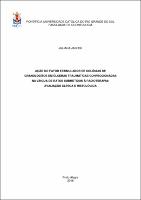| Share record |


|
Please use this identifier to cite or link to this item:
https://tede2.pucrs.br/tede2/handle/tede/6869| Document type: | Dissertação |
| Title: | Ação do fator estimulador de colônias de granulócitos em úlceras traumáticas confeccionadas na língua de ratos submetidos à radioterapia : avaliação clínica e histológica |
| Author: | Jasper, Juliana  |
| Advisor: | Figueiredo, Maria Antonia Zancanaro de |
| Abstract (native): | A mucosite oral (MO) radioinduzida é um efeito colateral altamente debilitante, que afeta a quase totalidade dos indivíduos portadores de neoplasias malignas na região de cabeça e pescoço, submetidos à radioterapia (RT). A gravidade desta injúria está diretamente relacionada a fatores pertinentes à terapia em si e às características individuais de cada paciente. Não há, até o momento, um protocolo padrão para o tratamento desta enfermidade. Sendo assim, o presente estudo objetivou analisar clinica e histologicamente a ação do fator estimulador de colônias de granulócitos (G-CSF) em úlceras traumáticas confeccionadas na língua de ratos Wistar submetidos à RT. Os animais foram alocados randomicamente em quatro grupos distintos: 1) RT + úlcera traumática + Filgrastim; 2) RT + úlcera traumática + soro fisiológico; 3) sem RT + úlcera traumática + Filgrastim; 4) sem RT + úlcera traumática. O Filgrastim (r-metHuG-CSF), um G-CSF recombinante, foi injetado diariamente nos animais pela via subcutânea, iniciando um dia depois do protocolo único de irradiação (30 Gy), imediatamente após a confecção da úlcera traumática. Uma vez concluído o tempo experimental de sete dias, os animais foram eutanasiados e tiveram a língua excisada, processada e corada com hematoxilina e eosina (HE). A avaliação clínica diferiu significativamente entre todos os grupos quanto à presença e ao tamanho da úlcera traumática, além do grau de severidade da MO radioinduzida, entre os grupos irradiados. Os grupos tratados com Filgrastim, submetidos ou não à RT, apresentaram uma melhor performance neste quesito. Histologicamente, houve maior resposta inflamatória nos grupos não irradiados, sem diferença estatisticamente significante entre a medicação estudada e os respectivos grupos controle. Baseado nos resultados clínicos encontrados, pode-se concluir que o uso do Filgrastim reduziu a manifestação e o grau de severidade da úlcera confeccionada e da MO radioinduzida. Esta é uma doença de patogenia complexa, a qual necessita investigações mais detalhadas sobre o real papel do G-CSF no seu manejo, para que uma indicação formal do seu uso possa ser recomendada com esta finalidade. |
| Abstract (english): | Radiation-induced oral mucositis (OM) is a highly debilitating side effect, which affects almost all patients with head and neck malignancies undergoing radiotherapy (RT). The severity of this injury is directly related to factors associated with the therapy itself and the individual characteristics of each patient. To date, there is no standard treatment protocol for this condition. Therefore, the present study aimed to evaluate clinically and histologically the effect of granulocyte colony-stimulating factor (G-CSF) on the healing of traumatic ulcers produced in the tongue of Wistar rats undergoing RT. The animals were randomly divided into 4 groups: 1) RT + traumatic ulcer + Filgrastim; 2) RT + traumatic ulcer + saline; 3) no RT + traumatic ulcer + Filgrastim; 4) no RT + traumatic ulcer. Filgrastim (r-metHuG-CSF), a recombinant G-CSF, was injected subcutaneously into the animals once daily, beginning 1 day after a single-dose radiation protocol (30 Gy), immediately after the traumatic ulcer was made. At the end of a 7-day experimental period, animals were euthanized and had their tongue surgically removed, processed, and stained with hematoxylin and eosin (HE). Clinically, all groups differed significantly in presence and size of traumatic ulcers, and the irradiated groups also differed significantly in severity of radiation-induced OM. Filgrastim-treated groups, submitted or not to RT, showed a better performance in this aspect. Histologically, there was an increased inflammatory response in the nonirradiated groups, with no statistically significant difference between the study drug and the respective control groups. Based on the present clinical results, we conclude that the use of Filgrastim reduced the manifestation and severity of trauma-induced ulcers and radiation-induced OM. This condition has a complex pathogenesis, which requires further detailed investigations on the actual role of G-CSF in its management before a formal recommendation regarding its use for this purpose can be made. |
| Keywords: | ESTOMATITES NEOPLASIAS DE CABEÇA E PESCOÇO RADIOTERAPIA ESTOMATOLOGIA CLÍNICA ODONTOLOGIA |
| CNPQ Knowledge Areas: | CIENCIAS DA SAUDE::ODONTOLOGIA |
| Language: | por |
| Country: | Brasil |
| Publisher: | Pontifícia Universidade Católica do Rio Grande do Sul |
| Institution Acronym: | PUCRS |
| Department: | Faculdade de Odontologia |
| Program: | Programa de Pós-Graduação em Odontologia |
| Access type: | Acesso Aberto |
| URI: | http://tede2.pucrs.br/tede2/handle/tede/6869 |
| Issue Date: | 18-Apr-2016 |
| Appears in Collections: | Programa de Pós-Graduação em Odontologia |
Files in This Item:
| File | Description | Size | Format | |
|---|---|---|---|---|
| DIS_JULIANA_JASPER_PARCIAL.pdf | Texto Parcial | 379.25 kB | Adobe PDF |  Download/Open Preview |
Items in DSpace are protected by copyright, with all rights reserved, unless otherwise indicated.




